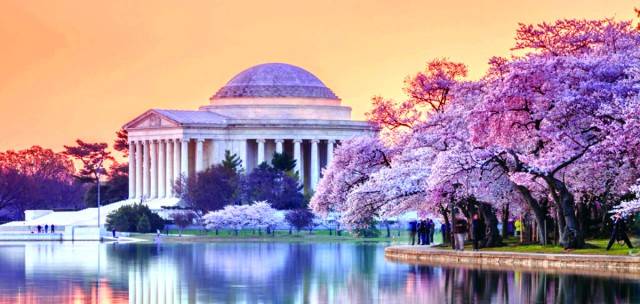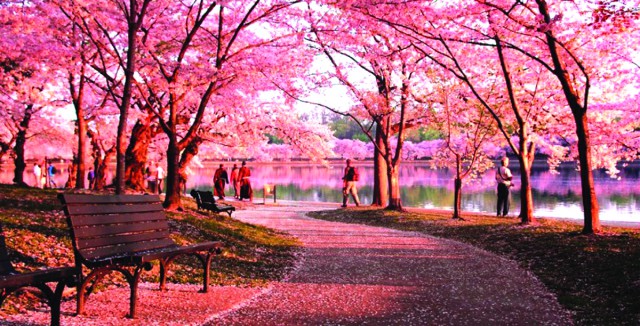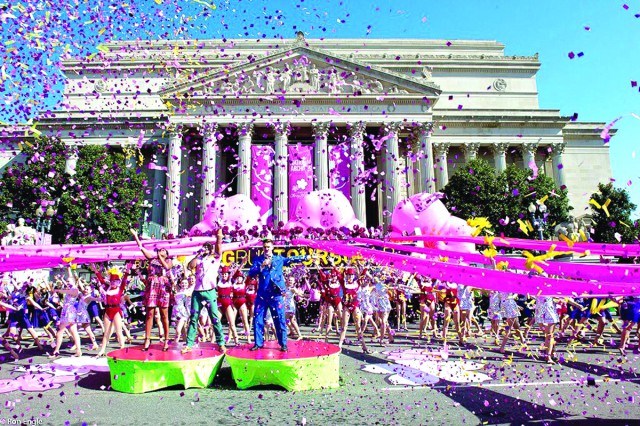
The annual National Cherry Blossom Festival, the signature event of Washington DC, heralds the arrival of spring, celebrating the end of winter’s gloom and lifting sagging sprits. This year it will be held between March 20 and April 11, 2021. The National Park Service estimates the blossoms will peak between April 2 and 5, when the cherry trees will be covered with beautiful white and pink flowers, presenting a spectacular and dazzling show by the banks of Potomac River in the heart of Washington DC. It is a virtual feast of colour and florescence.
The celebration in normal years draws thousands of visitors from around the world, providing a major source of income for the capital city’s hospitality business, hotels, restaurants and transportation. In 2019, an estimated 24.6 million tourists visited the city, spending about US$ 8.2 billion , providing a major boost to the local economy. The city showcased an array of colorful parades and floats, music shows, marching bands, art exhibitions and a galaxy of cultural and sports events. The crowds were entertained by nationally recognized talented dancers and musicians who performed during day-long events. Restaurants offered a variety of cuisines, ranging from delicate French dishes to hot South Asian curries.

Last year the city was already in the grip of the virus. The festival this year will also be different from years past, as, for all its past splendour, it cannot escape the sinister and all-pervading shadow of the pandemic. The city is still recovering from the deadly disease and the authorities are discouraging major public gatherings. A number of events, such as flower parades and the kite-flying festival that in previous years were popular have either been curtailed or will be held virtually. The Park Service has appealed to the public to enjoy the festival online, rather than in person, although a broad range of entertainment has been planned. This includes the traditional lights show, performances showcasing artists from Japan as well as local and national talent, while 25 giant cherry blossom sculptures will be on display throughout the city.
The festival was not designed entirely to amuse and entertain. A major theme is to foster international goodwill, especially between the US and Japan. Previously, this objective was advanced by the selection of national goodwill ambassadors from among young people interested in studying the Japanese language and culture. The ambassadors were accorded special privileges, invited to various ceremonies as honored guests, some receiving scholarships to visit and study in Japan for short durations. It is not clear if this tradition will continue this year.
The Cherry Blossom Festival has an interesting history that is almost forgotten now. The cherry trees were brought to Washington from Japan over a century ago. Their existence here owes much to the tenacity and singular perseverance of one woman, Eliza Scidmore. A gifted travel writer and photographer, her name would be unfamiliar today to most Washingtonians. Scidmore went on a vacation in Japan in the later part of nineteenth century, something unheard of for a single woman. She fell in love with what she saw in Tokyo’s charming parks: an abundance of blossoming cherry trees. She wrote in her travelogue, “Except Mount Fujiyama and the moon, no other object has provided the theme and inspiration for so many Japanese poems as the cherry tree.”
Scidmore was determine to introduce cherry trees to Washington, but all her efforts were unsuccessful. The US capital in those days was a vile, deathly swamp where dreaded diseases such as malaria and yellow fever were rampant. The US engineers concluded that the Potomac River might be serving as breeding grounds for these infections and decided to dry up the swamps. The land they reclaimed by doing so today is known as the Potomac Park. Scidmore proposed that cherry trees be planted in the Potomac Park to dampen the foul-smelling dumps that infested the newly recovered land. Her pleas were politely received by the officials but were rejected. However, the beautiful pictures of the blossoming trees she had brought back from Japan were universally admired.

A highly determined woman, Scidmore refused to give up. A lucky break came when William Taft became the 27th US president in 1909. His wife, Helen Taft, held enlightened and progressive views. She had lived in the Philippines and the Far East when her husband had served as the Governor of Philippines in 1901. She agreed to sponsor the cherry tree project as she thought it would make the capital, which she considered “a den of criminals and rendezvous of tramps,” a more livable place. It worked like magic. Soon, three-thousand cherry trees, a gift from the Mayor of Tokyo, arrived and on March 27, 1912, the first cherry trees were planted jointly by Helen Taft and Viscountess Chinda, the wife of the Japanese ambassador. In 1934, the cherry blossom festival became an annual event. Today, about 4,000 trees can be counted around the Potomac tidal basin where they were originally planted. In a curious twist, in 1981, a flood destroyed many cherry trees in Japan and Japanese horticulturalists had to request donations of cuttings from American trees to repopulate their own plantation.
Eliza Scidmore, the creator of the project, lived long enough to see the spectacular success of her venture and the sight of cherry trees fully blossoming by the riverbank. In 1928 when she died, the Japanese Government requested that her ashes be sent there to be interred with honor. Sadly, today, while there are commemorative plaques bearing the names of Helen Taft and the wife of the Japanese ambassador, there is no recognition of Scidmore’s seminal contribution anywhere.
It is reported that when, on February 22, 1912, Japan’s ambassador arrived in the US with great fanfare, he declared that “almost all the world is at peace today and will be at peace for thousands of tomorrows. War has had its day.” Alas, little did he know that in less than thirty years, in December 1941, the two countries would be engaged in a vicious, bloody conflict, the Second World War.
The writer is a former assistant professor, Harvard Medical School, and retired health scientist administrator, US National Institutes of Health
The celebration in normal years draws thousands of visitors from around the world, providing a major source of income for the capital city’s hospitality business, hotels, restaurants and transportation. In 2019, an estimated 24.6 million tourists visited the city, spending about US$ 8.2 billion , providing a major boost to the local economy. The city showcased an array of colorful parades and floats, music shows, marching bands, art exhibitions and a galaxy of cultural and sports events. The crowds were entertained by nationally recognized talented dancers and musicians who performed during day-long events. Restaurants offered a variety of cuisines, ranging from delicate French dishes to hot South Asian curries.

Last year the city was already in the grip of the virus. The festival this year will also be different from years past, as, for all its past splendour, it cannot escape the sinister and all-pervading shadow of the pandemic. The city is still recovering from the deadly disease and the authorities are discouraging major public gatherings. A number of events, such as flower parades and the kite-flying festival that in previous years were popular have either been curtailed or will be held virtually. The Park Service has appealed to the public to enjoy the festival online, rather than in person, although a broad range of entertainment has been planned. This includes the traditional lights show, performances showcasing artists from Japan as well as local and national talent, while 25 giant cherry blossom sculptures will be on display throughout the city.
The festival was not designed entirely to amuse and entertain. A major theme is to foster international goodwill, especially between the US and Japan. Previously, this objective was advanced by the selection of national goodwill ambassadors from among young people interested in studying the Japanese language and culture. The ambassadors were accorded special privileges, invited to various ceremonies as honored guests, some receiving scholarships to visit and study in Japan for short durations. It is not clear if this tradition will continue this year.
The Cherry Blossom Festival has an interesting history that is almost forgotten now. The cherry trees were brought to Washington from Japan over a century ago. Their existence here owes much to the tenacity and singular perseverance of one woman, Eliza Scidmore. A gifted travel writer and photographer, her name would be unfamiliar today to most Washingtonians. Scidmore went on a vacation in Japan in the later part of nineteenth century, something unheard of for a single woman. She fell in love with what she saw in Tokyo’s charming parks: an abundance of blossoming cherry trees. She wrote in her travelogue, “Except Mount Fujiyama and the moon, no other object has provided the theme and inspiration for so many Japanese poems as the cherry tree.”
Scidmore was determine to introduce cherry trees to Washington, but all her efforts were unsuccessful. The US capital in those days was a vile, deathly swamp where dreaded diseases such as malaria and yellow fever were rampant. The US engineers concluded that the Potomac River might be serving as breeding grounds for these infections and decided to dry up the swamps. The land they reclaimed by doing so today is known as the Potomac Park. Scidmore proposed that cherry trees be planted in the Potomac Park to dampen the foul-smelling dumps that infested the newly recovered land. Her pleas were politely received by the officials but were rejected. However, the beautiful pictures of the blossoming trees she had brought back from Japan were universally admired.

A highly determined woman, Scidmore refused to give up. A lucky break came when William Taft became the 27th US president in 1909. His wife, Helen Taft, held enlightened and progressive views. She had lived in the Philippines and the Far East when her husband had served as the Governor of Philippines in 1901. She agreed to sponsor the cherry tree project as she thought it would make the capital, which she considered “a den of criminals and rendezvous of tramps,” a more livable place. It worked like magic. Soon, three-thousand cherry trees, a gift from the Mayor of Tokyo, arrived and on March 27, 1912, the first cherry trees were planted jointly by Helen Taft and Viscountess Chinda, the wife of the Japanese ambassador. In 1934, the cherry blossom festival became an annual event. Today, about 4,000 trees can be counted around the Potomac tidal basin where they were originally planted. In a curious twist, in 1981, a flood destroyed many cherry trees in Japan and Japanese horticulturalists had to request donations of cuttings from American trees to repopulate their own plantation.
Eliza Scidmore, the creator of the project, lived long enough to see the spectacular success of her venture and the sight of cherry trees fully blossoming by the riverbank. In 1928 when she died, the Japanese Government requested that her ashes be sent there to be interred with honor. Sadly, today, while there are commemorative plaques bearing the names of Helen Taft and the wife of the Japanese ambassador, there is no recognition of Scidmore’s seminal contribution anywhere.
It is reported that when, on February 22, 1912, Japan’s ambassador arrived in the US with great fanfare, he declared that “almost all the world is at peace today and will be at peace for thousands of tomorrows. War has had its day.” Alas, little did he know that in less than thirty years, in December 1941, the two countries would be engaged in a vicious, bloody conflict, the Second World War.
The writer is a former assistant professor, Harvard Medical School, and retired health scientist administrator, US National Institutes of Health

